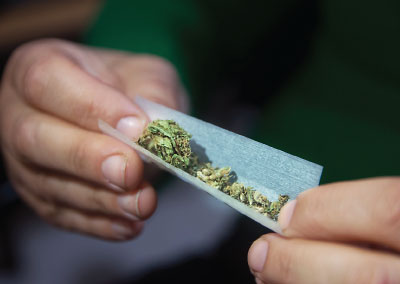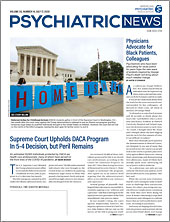Nearly half of people who regularly use cannabis experience cannabis withdrawal syndrome when they try to stop, according to a meta-analysis published online in JAMA Network Open in April. The highest prevalence occurs among patients in inpatient settings, followed by those in outpatient settings. According to the DSM-5, symptoms of cannabis withdrawal syndrome may arise within seven days of quitting or reducing the use of cannabis and include irritability, aggression, nervousness, anxiety, problems with sleep, changes in appetite, depressed mood, and physical symptoms such as headaches, sweating, and nausea.
“Cannabis withdrawal syndrome is clinically relevant and not something we should trivialize. It may be a reason people have difficulty quitting,” lead author Anees Bahji, M.D., a psychiatry resident at Queen’s University in Kingston, Ontario, told Psychiatric News. “The symptoms are terrible, which can set people up for a cycle where they try to make the symptoms go away by using cannabis again.”
Bahji and his colleagues analyzed data from 47 studies that included a total of 23,528 participants. They found that the overall prevalence of cannabis withdrawal syndrome in people who used cannabis regularly and then tried to quit was 47%. When the researchers broke the data down according to setting, they found the prevalence of cannabis withdrawal syndrome was 87% among inpatients, 54% among outpatients, and 17% among people in the general population who used cannabis.
Bahji offered some possible reasons for the higher prevalence among inpatients, as it is unlikely that they are admitted because they are experiencing cannabis withdrawal.
“This is speculation, but inpatients might be forced to withdraw from cannabis if they cannot continue to use it while admitted to hospital,” he said. “As well, people with other psychiatric conditions or substance use disorders might be more susceptible to cannabis withdrawal.”
The researchers found that the prevalence of cannabis withdrawal syndrome was higher among people who also used tobacco or other substances compared with those who did not. Although the meta-analysis was not designed to determine why, Bahji said that it’s not uncommon for people who use cannabis to use other substances because co-occurring substance use tends to be the norm, rather than the exception.
Bahji said that although cannabis withdrawal syndrome was first recognized in the fifth edition of DSM seven years ago, many health professionals and patients are not aware of it and that the study’s results should call attention to it as a medical condition.
“A lot of people don’t get treatment because cannabis isn’t seen as a ‘hard drug.’ That does a disservice to them because even though the severity [of cannabis withdrawal] might be less than what we’d see with opioids or other drugs, the fact that there is such a high prevalence of it tells us that this might be a huge issue,” Bahji explained.
He added that the results are noteworthy at a time when more and more states are legalizing cannabis use for medical and recreational use.
“When something is made legal, it might be perceived as safe, and some people may go ahead and use it,” he said, adding that the impact of widespread legalization on cannabis use and public health may not be apparent until several years down the road. Yet he stopped short of dismissing cannabis for medical use entirely. “I’m interested in seeing where the research goes because part of me believes there may be a therapeutic use for cannabis. I just think it will take a long time to tease that out—what component of cannabis should be used, how much should be used, and who could benefit from it.”
The authors reported no outside funding for this study. ■
“Prevalence of Cannabis Withdrawal Symptoms Among People With Regular or Dependent Use of Cannabinoids: A Systemic Review and Meta-Analysis” is posted
here.


